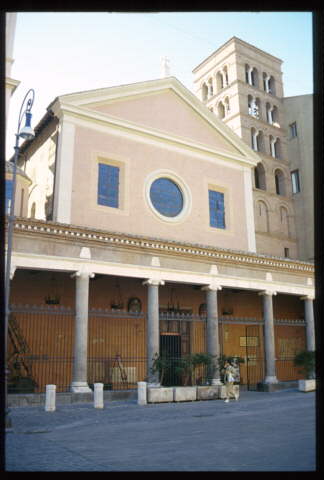
This site reflects the activities
of the Swedish Institute
of Classical Studies in Rome concerning the church of San Lorenzo in
Lucina. The involvment of the Swedish Institute began with excavations
made in 1993, 1995 and 1998 in the Early Christian baptistery of the church
in collaboration with the Italian archaeological authorities (Soprintendenza
archeologia di Roma), which had made important excavations beneath the
church in the years 1982-1987. The Swedish excavations will be published
together with a number of cross-disciplinary studies about the Roman remains
beneath the church, the church itself and its surroundings from the second
century AD and until today, made in 2000-2002.
The church of San Lorenzo in Lucina
was built in the fifth, or perhaps already in the fourth century AD and
is still standing in the modern Piazza San Lorenzo in Lucina. Today,
the Piazza is pedestrian and the façade of the church has recently
been restored. The church itself and the Piazza are both more beautiful
today than only 15 years ago,
when the Piazza was full of cars, as you can see in this
photo from 1987.
What kind of church is this?
The church or basilica was built
for one of those 25 earliest parishes or tituli which were created
in the fourth and fifth century AD as a result of Christianization of the
inhabitants of Rome. This church is not a cathedral, where the bishop leads
the liturgical life of an entire town, but a parish, where priests lead
the spiritual and charitable activities in a local quarter.
What does it name mean?
The double name San Lorenzo in
Lucina means that the church building, the basilica, has been dedicated
to the martyr Laurentius (dead in 258), probably in the fifth century,
while the name Lucina probably belonged to a woman who contributed to the
creation of the parish (titulus) in the fourth century. If the basilica
was built already in the fourth century, as recent research seems to suggest,
it was probably originally called basilica Lucinae, just like most
fourth century basilicas who carried the name of their founder and not
of a saint or martyr.
|
NEWS
Latest additions:
A new study by Agneta Freccero
on Roman painted plaster from San Lorenzo in Lucina
(2002-09-18)
Earlier news:
"Head
of St. Laurentius" exposed on his feast day.
(2002-08-10)
Visitors
(2002-06-20)
Christmas
2001 at San Lorenzo in Lucina (2001-12-14)
New section: News
and people
Prayer
at noon for victims at San Lorenzo in Lucina
(2001-09-14)
New
exhibition inaugurated at San Lorenzo in Lucina for 75th anniversary of
the Swedish Institute in Rome
(2001-09-14)
A
4th c basin for ritual feet washing?
(2001-04-12)
New
photos of the medieval inscriptions (2001-02-06)
New
Early Christian texts about Baptism (2001-01-26)
Conservation
and research (2000-12-20)
Early
Christian links (2000-12-09)
Why
San Lorenzo in Lucina? (2000-11-30)
A
360° photo of the excavation of the Early Christian baptistery in 2000.
Inscriptions
in the portico
|
